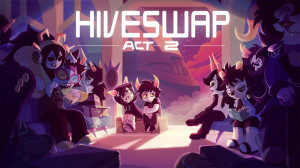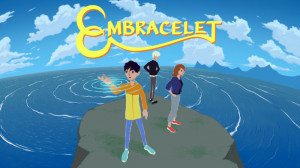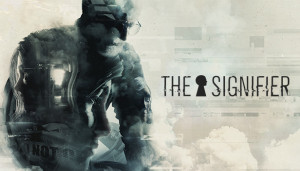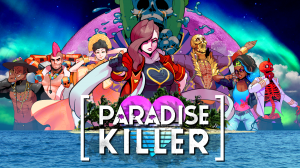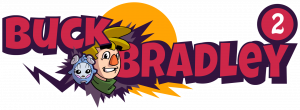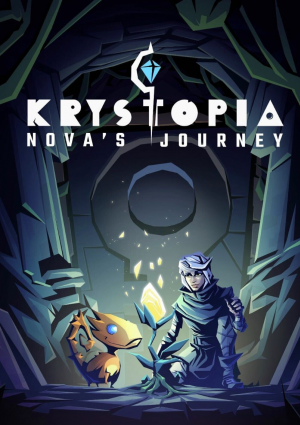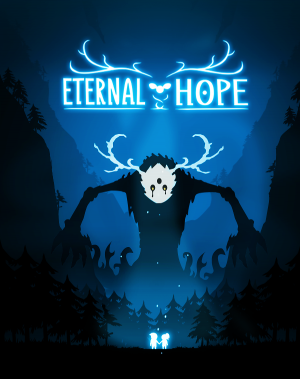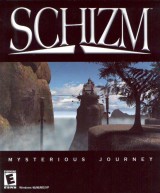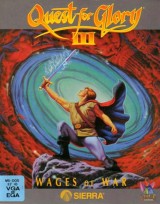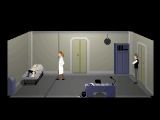Review for Hiveswap: Act 2 – Dead Freight
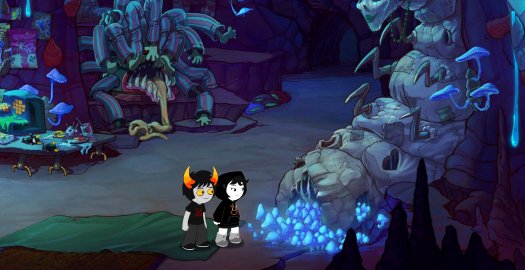
Apparently, with nearly 2.5 million words, it would take the average person more than 5 entire days to read all of Andrew Hussie’s web comic Homestuck from scratch. That’s an impressively sizeable amount of canon to draw on for Hiveswap, the beautiful and charming point-and-click adventure developed by What Pumpkin Games and set in the same universe. Act 1: Kansas City Shuffle was released back in 2017, several years after the incredibly successful Kickstarter that led to its creation. Now Act 2: Dead Freight, the second part of four, is here with more of the same stunning visuals and marvellous music.
Act 2 starts exactly where Act 1 left off on Alternia, with our protagonists Joey Claire (young Earthling who aspires one day to be a vet) and Xefros Tritoh (equally young, but with more horns and a native of Alternia) riding a deer-like creature (called a lusus) away from the evil Heiress who controls the planet with an iron fist. Joey is new to this strange and alien world, having been suddenly catapulted there by a mysterious portal in her attic after a fraught series of battles with some serpent-like, sinister aliens. These snakey critters showed up uninvited at the house on Earth she shares with her brother Jude and her often-absent father. Thankfully, if it’s been a while since you played the first part, there’s the option of a quick text-only recap to get you up to speed.
Catching up is pretty useful because the lore for this world is vast. Xefros, for example, is a troll of the rust caste, with burgundy blood, considered in this society to be the lowest of the twelve blood colours. In line with his social stature, he’s generally submissive to others of a higher class, and has an extremely low opinion of himself. Here mother grubs give birth to trolls, distance is measured in capacioniters, and eyes are known as viewglobes. If you’ve never read Homestuck or played any of the related visual novel-style games set in the same universe (Pesterquest and Hiveswap Friendsim), however, don’t worry. Despite the raft of new and unfamiliar terms, it’s easy enough to pick up the gist to follow – and enjoy – the story as it unravels. There’s ample opportunity to explore the lore by thoroughly examining every area you visit, with many pictures and objects that are there solely for the purpose of world-building.
Joey and Xefros started to bond in Act 1 after helping each other get through a couple of tricky situations, and now instead of trying to find her way home to Earth, Joey is committed to helping Xefros and his friends with their rebellion against the tyrannical rule of the Heiress to the Alternian throne, Trizza. Our first goal is to find one of those friends, a troll of quite significant influence (more than a billion followers on ‘Chittr’, in fact) named Cridea. The plan to reach her by train is immediately scuppered, with a sudden explosion blasting our heroes out of the train station, waking up in a nearby forest. Time to head through the forest to the next station and ultimately to Jeevik Island, where Cridea is busy partying. Of course, there’ll be obstacles along the way and plenty of quirky trolls to meet of all blood colours, including the purple-blooded and possibly shady celebrity clown Marvus; and a waifu-loving, katana-wielding teal-blooded edgelord called Tegiri who verbally narrates his own actions.
Just like the first part, Dead Freight is aesthetically gorgeous. Though the characters themselves are fairly simply drawn, they’re well animated (and wonderfully so in the occasional cutscenes) and the hand-painted backgrounds pop with purple hues and detail, really bringing to life this strange and alien world. In one early forest scene, acid-filled trees sway in the background, fish leap in a gushing stream, and a giant bug nibbles on garbage while a pale lusus companion creature swishes its tail. The attention to detail is impressive and always a pleasure to look at. The usual cartoony art style switches for the trial portion of the game (more on that later), giving us a chance to see some of the characters in a more detailed visual novel style.
The music playing in these scenes is as beautiful as the visuals. The tracks are eclectic: in the forest we’re treated to a bewitching orchestra of smooth, lilting sounds; soon after on a farm is a soothing piano tune that makes you want to stick around and start growing turnips – if it were that sort of farm, anyway (this seems to be more of a bee farm). In another location – a futuristic-looking train station – the tapping of the protagonists’ footsteps across the shiny floor is accompanied by a synth tune with an almost reggae beat, occasionally interrupted by unintelligible station announcements over the loudspeaker. The default volume settings are such that ambient sound effects are pretty much lost until you alter the mix; for example, when I finally boarded the train I thought background chatter was conspicuous in its absence, but turning the SFX up and the music down fixed the issue.
Sadly, there’s still no voice acting; instead, dialogue is accompanied by typewriter-like sounds clattering away as the conversation’s text gradually appears in a window at the bottom of the screen. Bizarrely, Xefros’s dialogue somehow contains emojis... X:) If you’re wondering about the inclusion of the X, it’s meant to depict troll horns. You may also find his speech somewhat aggravating if you’re a fan of punctuation: he doesn’t use apostrophes, and hardly anyone seems to bother with capital letters. In fact, all of the characters you briefly meet on your journey have their own particular conversational style. Fozzer, a troll brandishing a spade in the train station, talks_like_this; Folykyl, also waiting for a train and hugging a giant insect lusus, speaks with large pauses; and Galekh, an erudite intellectual higher-blood on the train speaks at length and with footnotes.
The basic mechanics and interface haven’t changed much since the last episode, remaining simple and intuitive. The cursor will switch to an appropriate icon when you hover it over most areas in a scene – footprints to move around, or a hand to interact in some way. Interacting with an item sometimes brings up a circle with an additional verb choice in it, such as choosing whether you’d like to look at the object or take it. The top of the screen still contains your inventory (in fact, you start off with the same items you had at the end of the last part), icons for special actions (such as Joey’s dance moves or Xefros’s telekinesis), an alien tablet used for communication, portraits of the two main characters which you can use to switch between them, a question mark for the hint function, and the main menu button. From the main menu you’re able to manually save the game in multiple slots, in addition to the game’s own autosave function. Handily, you can hide the whole top panel with a simple click if you’d prefer to soak in more of the beautiful scenery.
Using an inventory item is as simple as clicking on it and then clicking on either another inventory object, or an item in the background scene. However, when you have something selected, there’s no custom cursor icon to show what you’re ‘holding;’ instead, a small white square is added to your cursor (regardless of what the item is). It’s a really minor point, although it’s a little disappointing for a game that’s so polished in other areas. You also don’t seem to be able to get any descriptions of the items once they’re in your inventory.
On the plus side, there are some mildly amusing custom responses when trying to combine/use items in incorrect ways (e.g. trying to use one of your dance moves to get across a stream: “If you were Jesus Christ, you could easily tap dance on the water. Unfortunately you are just Joey Claire.”) In fact, there’s a vast amount of flavour text and dialogue to be discovered from exploring, as switching from Joey to Xefros (which you can do at almost any time) and inspecting the same items will give a different response. With the exception of the obvious class struggle on Alternia, the tone of the writing is quite light-hearted (and often sweary), provoking a smile here and there, although without ever really being laugh-out-loud funny.
There’s no hotspot highlighter, which, given that most of the areas are packed with different things to examine, does mean that it can be easy to miss something. That adds a bit of challenge to some of the puzzles, which are for the most part logical (at least, what passes for logical in this bizarre and curious world) and not too taxing. Xefros’s telekinesis powers and Joey’s dance moves both come into play on a handful of occasions as you navigate your way through the alien landscape, whether it’s breaking into a farmhouse or impressing a bee. Your alien tablet is used infrequently for sending private messages on Chittr at certain scripted points, helping to drive the plot forward.
In between the standard inventory and basic dialogue puzzles, there’s an annoying mini-game where bees are flying into different holes; the objective is to hover your cursor over each hole (or press a corresponding key) as soon as a bee enters it, roughly in time with the music. These kinds of unskippable timed action sequences are a real bugbear of mine in games that are otherwise about puzzle solving, exploration and story. If I wanted to play Dance Dance Revolution, I would. On this occasion success is rewarded by bee vomit from a giant insect, so… yay?
There’s also a couple of battles, much like the first game except you’re fighting trolls rather than serpent beasts – these are just puzzles in another format, so there’s no need for fast reflexes. To add to the gameplay variety, towards the end you get embroiled in an impromptu Phoenix Wright-style trial (visual novel art included), defending a jade-blood accused of stealing a religious rainbow drinker (vampire) romance book. You’ll need to quiz all the suspects and witnesses, as well as finding evidence to present during the trial and pin down the culprit. It’s a fun digression to start with, but it’s incredibly dialogue-heavy and feels like it drags on well past its welcome. In Phoenix Wright you’re solving serious crimes so there’s some weight to the outcome, whereas I didn’t feel particularly invested in catching who’d stolen a teen vamp novel, or listening to the jade-bloods’ petty infighting.
In the event that you get stuck on any of the puzzles, in this act the hint system is functional (unlike the last – I tried on a number of occasions in Act 1 and the game informed me the hint system was unavailable), with the question mark in the top right of the screen providing progressively more explicit clues when requested, although it only works while controlling Joey. It is possible to trigger a game-over if you make a poor choice in the trial or decide to do something reckless in other areas. If you do, though, after a brief cutscene depicting your unfortunate loss/demise, you’ll be deposited back to where you were just before you failed, so no progress is lost, and you may even get an achievement for your troubles.
It’s also worth mentioning that the game gives you the option to import your save from Act 1 so that it can “remember your choices,” and I did so for this playthrough. However, although there are some mutually exclusive dialogue options, it’s a fairly linear experience so it seems unlikely this would have any significant effect on the plot. The Steam store page teases that importing a save may “unlock hidden secrets.” Unfortunately, I don’t think I was smart enough to find them!
When the puzzling is done and the episode reaches its next cliffhanger ending after around eight to ten hours of playtime, we’re actually not that much further forward in the overarching, multi-act plot than when we started. It’s a mostly fun diversion, though, and it significantly expands our understanding of the rich world of Alternia. Hiveswap: Act 2 – Dead Freight flounders sometimes in its pacing, but features the same strikingly detailed art and cracking original soundtrack that the first episode boasted, and is brimming with creativity. Onwards to Act 3. X:)
WHERE CAN I DOWNLOAD Hiveswap: Act 2 – Dead Freight
Hiveswap: Act 2 – Dead Freight is available at:
We get a small commission from any game you buy through these links (except Steam).Our Verdict:
Hiveswap: Act 2 can be a little slow in places and doesn’t take us very far in the overall story, but it’s nevertheless a charming and beautiful point-and-click adventure set in a fully fleshed-out, intriguing alien world.


